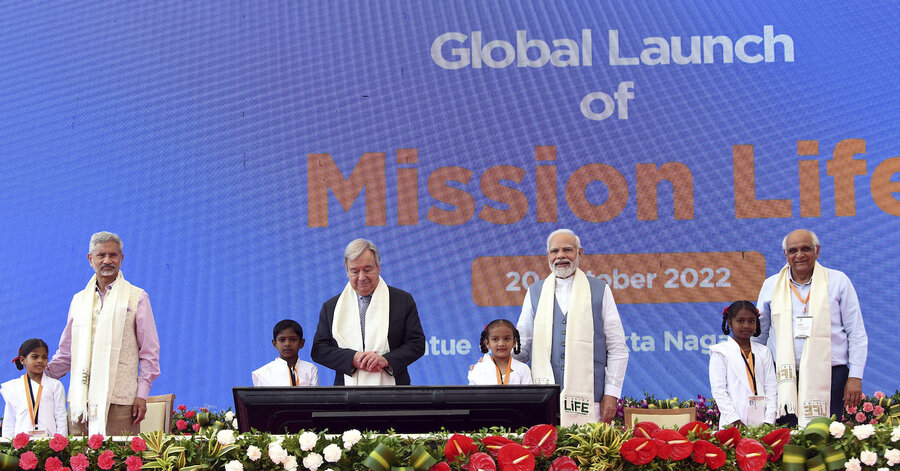India launches sustainable lifestyle program to boost green energy
Loading...
| Bengaluru, India
The Indian government’s flagship program to encourage individual and collective action on climate was launched by Prime Minister Narendra Modi and the United Nations Secretary-General on Thursday.
Mission Life, where “life” is an acronym for “lifestyle for environment,” is designed to encourage individual behaviors like switching off vehicle engines at traffic lights, turning off taps when not in use, and switching to longer-lasting alternatives to single-use plastic bags. The government estimates those actions, if taken on a national scale, could significantly limit emissions, water use, and waste.
The program hopes to “mobilize one billion Indians as well as people in other countries to become individuals who practice sustainable lifestyles,” Param Iyer, CEO of Niti Aayog, a government-supported think tank that are spearheading the Mission Life program alongside India’s federal environment and climate change ministry.
U.N. chief Antonio Guterres, who was at the program’s unveiling in the western Gujarat state, hoped the focus on more sustainable living “can spread throughout the world.”
While they see the potential benefit of such a program to reduce emissions, climate experts are still unclear about how the project will play out.
“At an individual level, Mission Life is a welcome measure, both ethically and environmentally,” said Nagraj Adve of the climate advocacy group, Teachers Against the Climate Crisis.
But he added that “the program needs to be complemented by enabling policies such as higher income and wealth taxes, making flights more expensive, promoting renewable energy, and more public transport” to encourage lifestyle changes.
“It still remains to be seen if the government will work towards all of this.”
Alongside Mission Life, a conference in New Delhi took place on Oct. 18 that addressed energy and how to transition to cleaner options.
For countries to transition away from fossil fuels and toward cleaner energies like solar power, supply chains for components need to be more geographically diverse, officials said during the conference.
Currently, 75% of components needed for solar power are manufactured in China, according to a recent report by the International Energy Agency. Representatives at the fifth assembly of the International Solar Alliance, made up of 110 member countries, want that to change.
“By 2030, we expect that solar will be the cheapest source of electricity in most geographies,” said Ajay Mathur, director general of the ISA.
Adding that freight prices have spiked, Mr. Mathur urged for “multiple regions from which solar photovoltaic products can go from the producer to the supplier” to ensure that more nations benefit from the cheap prices of solar energy.
Launched by India and France at the 2015 Paris climate conference, the ISA aims to promote the use of solar energy as countries look to reduce their fossil fuel use to curb global warming. And although China has invested over $50 billion in new solar supply capacity – ten times more than Europe − and created more than 300,000 manufacturing jobs, it is not part of the alliance.
“China’s policies have contributed to a cost decline of more than 80%, helping solar photovoltaics become the most affordable electricity generation technology in many parts of the world,” said senior International Energy Agency analyst Heymi Bahar. “However, they have also led to supply-demand imbalances.”
Mr. Bahar added that the global market is almost entirely reliant on China for solar products, with 15% of global supply coming from one Chinese plant alone, leading to concerns that the world is too reliant on a few, concentrated supply chains.
“This concentration has already resulted in prices increasing during the Covid-19 pandemic and extreme weather events” in China when exports were disrupted, Mr. Bahar said. ”Diversification will result in a more secure supply chain.”
Industry experts say that a diversified supply chain can also increase employment, grow economies, encourage innovations, provide energy security as well as help countries achieve their climate goals.
“Right now, the jobs that are being created in countries like India are largely in the construction and installation side of things and not on the manufacturing side,” said Ulka Kelkar, who directs India’s climate policy analysis for the World Resource Institute. “To really benefit from the full potential of the job creation possibilities of solar manufacturing, it is important to diversify.”
India’s federal minister for power, RK Singh, told the conference that countries have “the responsibility of enabling development in the parts of the world that lack access to energy and energy security.”
The Indian federal government recently approved funding to the tune of $2.6 billion for a production-linked incentive scheme that would encourage domestic solar module manufacturing. The United States’ Inflation Reduction Act also encourages domestic manufacturing of solar power components.
The solar energy market needs to grow tenfold by the end of the decade if global climate goals are to be met, according to both the ISA and the International Energy Agency.
The ISA’s assembly, which runs until Wednesday, also announced programs that will encourage investments in solar energy in Africa as well as help start-ups in the solar energy space.
This story was reported by The Associated Press. AP reporter Sibi Arasu contributed to this report.







